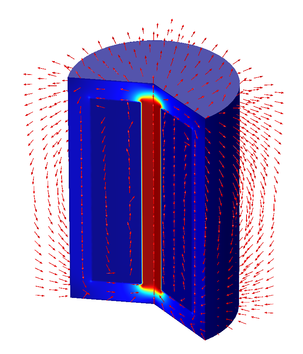
Smart materials are able to convert one form of energy to another. These materials can be either solid or fluid, and are typically located within what’s called a smart structure. What makes these materials and structures so “smart”? Let’s find out.

Nonlinear magnetostrictive transducer, a sectional view of the magnetic flux density.
Smart Materials inside Smart Structures
Smart structures are active devices that sense and respond to their environment in a desired and predictable fashion. In order for smart structures to work in this way, they need to contain sensors and actuators made out of smart materials. Although the structure is also considered smart, it’s really the materials within that deserve the credit. These are capable of converting one form of energy input into the desired form of energy output.
Wait a minute, just because something can convert energy from one form to another, does that make it inherently “smart”? Let’s consider how a motor gets a washing machine moving. In order for the motor to generate mechanical energy, we need to supply it with electrical energy, and then all the mechanical parts rely on each other to move the machine.
Now consider this: smart materials are able to transduce energy on their own — without the need for bulky, moving pieces.
Piezoelectricity, Piezoresistivity, and Magnetostriction
Smart materials are innately able to pick up on environmental cues, such as temperature, electric or magnetic fields, stress, or moisture, for instance. When it picks up on external stimuli, the material itself changes. During these alterations in shape or physical properties, the material then converts the energy. Whereas if you leave the parts of a washing machine motor to fend for themselves nothing will happen, a smart material doesn’t lose its ability to convert energy. Nature has given us a variety of smart materials to choose from such as piezoelectric, piezoresistive, or magnetostrictive effects. The appropriate use of a smart material depends on which one of these effects it exhibits, but some applications include self-sensing actuators, energy harvesting, active vibration control, and active shape control, to name a few.
On April 11th we’re holding a webinar on this topic, and my colleague Supratik Datta, Applications Manager, will tell you more about how smart materials work, what the different types are, and how to model them in COMSOL Multiphysics. Be smart — don’t miss out!




Comments (0)